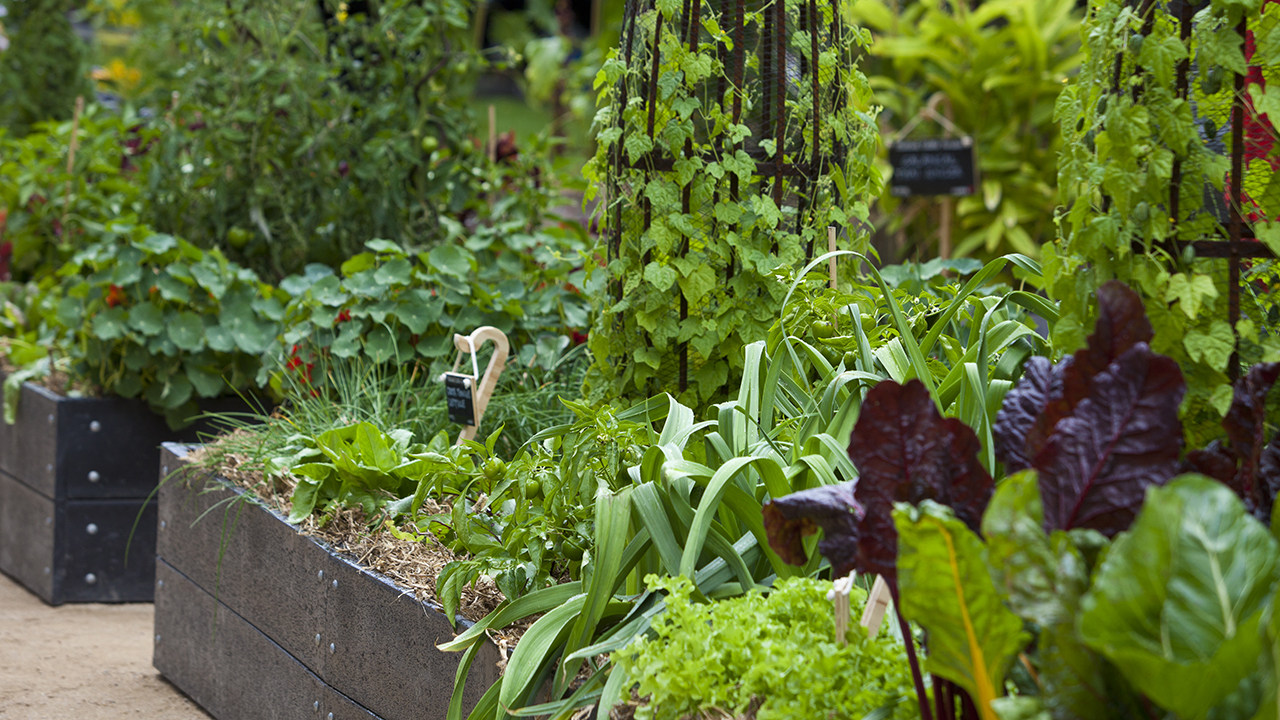Lesson 4 - Growing methods

From a site assessment, you will have identified what parts of your space are best for growing and started to plan your food garden in more detail. Many food plants can be grown directly into prepared beds on site, particularly where the site is level, but gardeners often prefer raised beds, especially in heavier soils or where there is poor drainage. Raised beds need to be at least 15cm deep but if you are growing root crops of any kind, then a depth of at least 30cm is recommended.
You can make or purchase raised beds made of timber or metal - ideally, these are up to 100cm in depth. They provide ideal growing conditions for many plants and are excellent for those with access or mobility difficulties. Any raised bed will need to be filled with high-quality soil and benefit from regular additions of compost between crops. It's worth considering that the more elevated the bed is off the ground, the higher the irrigation needs will be. And, of course, containers can also be a great solution for growing food, but we will cover this much more in a future module.
Diggers tip
If you are planning to use raised beds, make sure they have sufficient depth and volume, particularly to grow any woody plants such as shrubs or small trees successfully.
No-dig gardening has been popular in recent years but was first described by Japanese farmer and author Masanobu Fukuoka in his seminal 1953 text The One-Straw Revolution. No-dig gardening techniques vary but typically involve building a bed from the base up, starting with a layer of thin cardboard or newspaper, overlaid at the edges and thoroughly wetted to assist with decomposition. Alternating layers of compost, straw and manure are then added to a depth of around 30cm before finishing with a compost layer for planting your seedlings. Most no-dig beds are best made with walls or edges of some kind, although they can also be laid directly in situ.
Diggers tip
Diggers tip: Control any perennial weeds, particularly grasses, before applying your base layer (paper, cardboard). Otherwise, these can rapidly take over the bed and undo all your hard work!
There are many ways of gardening, but in the 21st century there is an emphasis on trying to be more environmentally sustainable in the methods we use, particularly to grow food.
Growing organically excludes the use of synthetic fertilisers, pesticides and herbicides; some also reject using genetically modified plants. Organic growing has a central focus on maintaining soil health and fertility, particularly through the use of composts and manures, and techniques like crop rotation, cover crops and minimising cultivation. Natural control methods for pests and diseases are used, as well as methods that promote plant health and pathogen resistance, such as increasing diversity and companion planting.
Biodynamic gardening is very similar to organic gardening but is guided by principles outlined by German philosopher Rudolf Steiner in the 1920s. This includes linking aspects of cosmos on gardening (such as activities based on the lunar cycle) and using specific biodynamic preparations to stimulate soil and plant health. Biodynamics also has an emphasis on closed-loop systems and waste recycling to maintain soil fertility and work more in harmony with nature.
Permaculture is derived from ‘permanent agriculture’ and was first coined by Bill Mollison and David Holmgren in the 1970s. It is regarded as a holistic design system, not just for growing but for more sustainable living. Permaculture approaches to growing have a focus on working with nature, including understanding nutrient cycles and learning from natural patterns, functions and systems. This includes recycling organic wastes and returning them to the soil, and planting design and management to maximise resource use and efficiency. There is a strong emphasis on planning and design in permaculture, particularly integrating people, animals and communities.
Crop rotation is a sequence of planting different vegetables on the same bed over several years to reduce diseases and pests and to improve soil health and fertility. There is good evidence that rotation helps disrupt the lifecycles of many soil-borne pathogens, reducing the need for controls in subsequent crops. It can also assist in managing soil nutrition by adding legume crops (e.g. peas) and green manure crops (e.g. mustard or ryegrass), which add nitrogen to the soil as part of the rotation process. Rotation cycles vary from 2-3 years to several years, with a key principle being to avoid plants of the same group in subsequent plantings on the same patch. One example of a rotation cycle might be first growing a Solanaceae crop (e.g. tomatoes, capsicums), followed by a legume (e.g. beans, peas), followed by root or Allium crop (beets, carrots, onions), followed by a Brassica crop (cabbage, broccoli, etc.) and then finally a Cucurbit (e.g. cucumbers, zucchini, pumpkin, etc.). A green manure crop could be grown instead of a legume, or even a fallow period used.
Many vegetables and fruits need specialised training and support systems to grow and produce successfully. This can include temporary staking for some vegetables through to more permanent structures such as a trellis or frame to support vines and fruit trees. Some gardeners also find that netting is needed to protect many food plants. This includes protection from birds, particularly fruit and nut trees, and from insects, such as cabbage while butterfly and fruit fly. Always make sure you are using the right mesh size netting for the right purpose. In some states there are regulations on the type of bird netting that can be used.
Diggers tip
If you believe you need to support and protect your plants from wind, pests and animals. Include this factor when planning your garden beds.